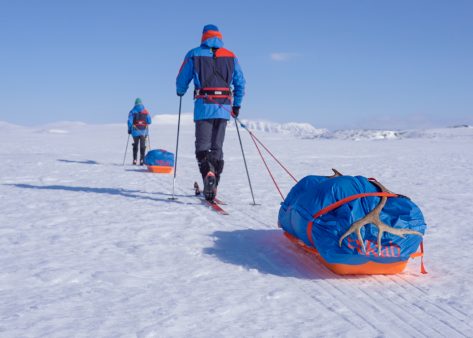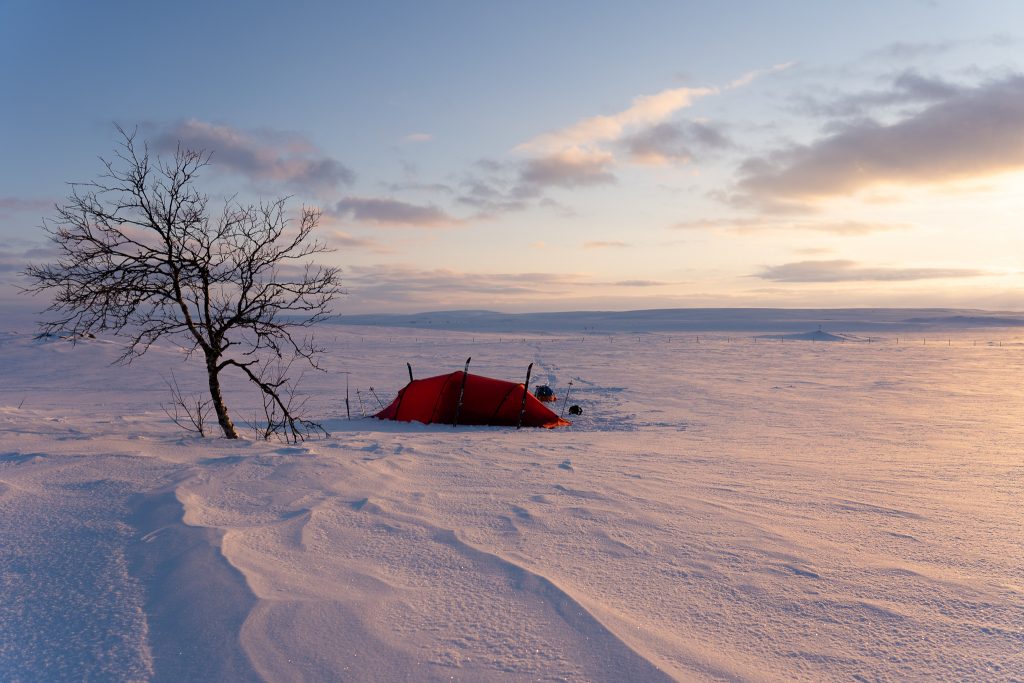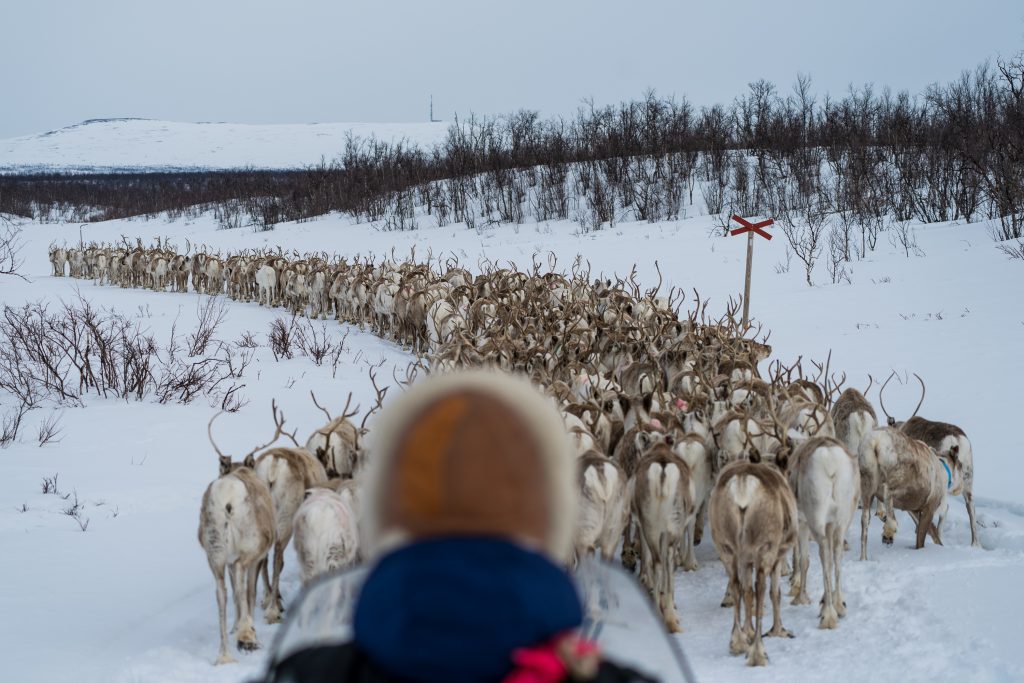Exploring Arctic Connections
25 September 2019
By Luke and Hazel Robertson
A journey millennia old – deeply rooted in nature and connected with the natural cycles of the seasons. Far above the Arctic Circle, anticipation is building. Struggling to be heard above the sound of rumbling snowmobiles and clanging bells, human voices deliver sharp instructions to one another. During a lunch break, where the animals rest, tactics for the long days ahead are discussed over a crackling fire.
As the northern lights dance playfully overhead, reindeer gather, and eventually herds – sometimes thousands strong – will start their arduous migration towards the coast. In a journey fraught with danger, there’s safety in numbers. The Sami reindeer herders know this too; trust and co-operation is required on this journey.

In April this year we spent a month in Sápmi – a region that includes what is now northern Norway – on our Arctic Connections expedition, to better understand the impact that climate breakdown and industrial development of the Arctic is having on people and the environment. Here, at 70oN, we set off on a 250km long-distance ski expedition to make our own personal connection to Sápmi. We were on a journey to document, through a series of filmed interviews, the lives of those who live here and who know it best.
Skiing across Finnsmarkvidda from Alta to Karasjok we crossed the beautiful and huge Iešjávri Lake, glimpsing the mountains on the far side that we would ski past on our return journey to Alta several weeks later. Temperatures plummeted to -20oC overnight on the plateau and we awoke with frost on the inside of our tent where the condensation from our breath had frozen. Descending from the plateau our journey was accompanied with the distinctive call of ptarmigans (or rypein Norwegian); hard to spot as they blended into the snow with their white plumage and only really visible through jolting movement as they scurried between shrubs and stunted birch trees or took to flight as we approached.
We skied the last fifteen kilometres into the village of Karasjok along the meandering Karasjok River, as it wound its way into the town and past the Sámi Parliament. Here, only a couple of days later, we would have the privilege of interviewing the three-term President of the Sámi Parliament of Norway, Ms Aili Keskitalo. We couldn’t have asked for a more fitting arrival.

For over an hour Ms Keskitalo spoke passionately in English – her third language – with a deep determination about her aim of ensuring that the rights of the indigenous Sámi across Sápmi are represented and respected. She touched on how the mass protests against the building of the Alta Dam in the 1970s and 1980s led to the creation of the Sámi Parliament of Norway and how there is much to be learned from the Sámi people in terms of living in sync with nature and adopting a circular economy approach to using natural resources.
We also spoke to and spent time with three separate young reindeer herders, Jon Mikkel Eira, Juhaen Gaup and Lars Johan Anti, who all talked about how the migration is changing with warmer winters and more challenging snow conditions. This year Jon Mikkel Eira’s herd, along with many others’, had to be transported to the coast in trucks; layers of ice in the snow pack meant the reindeer couldn’t get to their food source – mainly lichen – under the snow. In what was a hugely special moment, we had the honour of accompanying Lars Johan and his father at the beginning of his reindeer herd’s spring migration northwards.
Whilst in Karasjok we also interviewed Inga Utsi, the inspirational young leader of the Karasjok/Kautokeino branch of Sámi youth organisation Noereh, to hear what life is like as a young Sámi woman. Inga touched on a wide range of topics including: the pressures she and many other indigenous people feel to continue their traditional culture, whilst balancing this with studying and dreaming of seeing the world and how today many young Sámi people are inspired by their activist grandparents, who were involved in the Alta conflict.
To offer a balanced approach to our interviews, we discussed one of the most contentious issues in Sápmi at the moment, the development of a controversial copper mine in the Repparfjord area of Sápmi, with the CEO of the company who wants to build it. The mine has brought many in the Sámi community, politicians and environmentalists alike, to question the balance between the true extent of its environmental and societal impact – and the requirement for increasing amounts of copper in the age of electrification as a solution to the climate crisis.

After leaving Karasjok on skis and heading north, we passed Lars Johan’s herd one last time and followed in the hoof-prints of another herd already making their way to the coast. During the return journey, unseasonably warm temperatures arrived, refusing to fall below zero overnight, with rain falling on several of the days we skied. The unmistakable pattering noise on our tent meant it felt more like a mild, wet Scottish winter wild camping trip than the Arctic.

Then, as rivers began quickly opening up, crossings became perilous, with a twenty centimetre layer of surface water sitting on top of the frozen lakes. Our final day was memorable, but for the wrong reasons. Akin to water-skiing, our pulks floated and bobbed along behind us as we sloshed through the water and eventually back to Alta.
With the Arctic warming twice as fast as the rest of the world, the landscape is changing – and millennia-old journeys like the spring reindeer migration, are being forcibly changed too. There is a stubborn resilience to the Sámi, borne out of centuries of persecution and discrimination against them. This is evidenced, both in successfully keeping many ancient traditions alive today and adapting to change, and also in standing up for their rights when pushed too far.
This was the case with the Alta conflict and the Repparfjord copper mine appears to be rekindling an activist approach among many in the Sámi community. As is the case in Sápmi, those in society who are contributing the least to the climate crisis are being affected both by its effects and the attempts of humans to find solutions to it. It is up to all of us to ensure that the just transition to a more sustainable future for all doesn’t leave anyone behind.
Thanks / giitu / takk to everyone in Sápmi that has made ‘Arctic Connections’ what it is – we are humbled to have met you.
Luke and Hazel Robertson are Explorers in Residence for the Royal Scottish Geographical Society and Guides for The Polar Academy. Both are passionate about driving action on climate change and understanding the connection between people and place.
You can follow Luke and Hazel’s adventures at www.everyday-exploring.com, or on instagram @hazelrobertson and @lukerobertson.
- From the Floe Edge: Visualising Sea Ice in Kinngait, Nunavut
- Bridging Knowledge and Action: A Polish-Norwegian Perspective on Arctic Science-Policy Collaboration
- Unpacking the Motivation Behind Wintering at Polar Stations
- Working the Ocean’s White Gold: A Nutshell History of a Living Bering Strait Tradition
- Political Participation in the Arctic: Who is heard, when, and how?